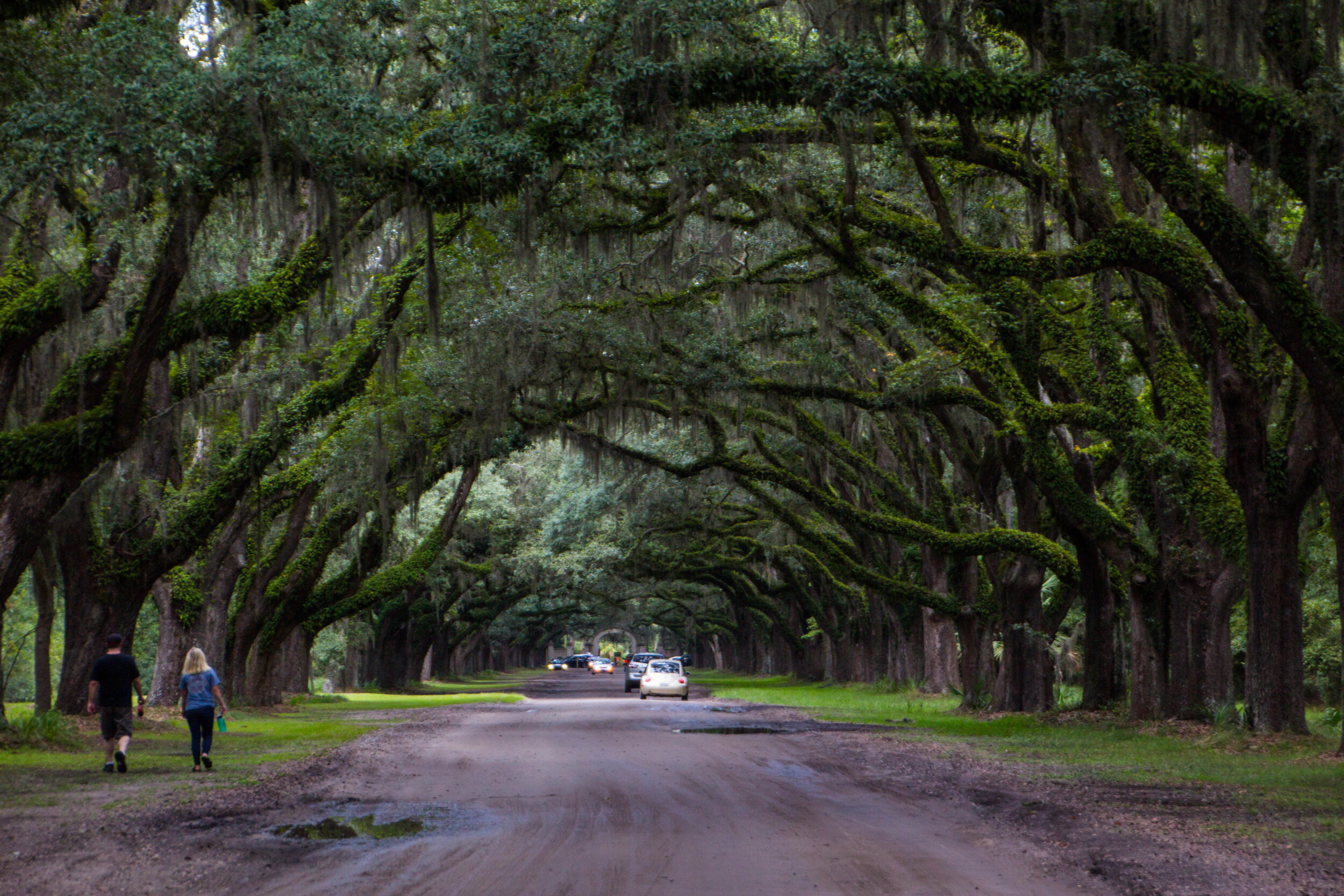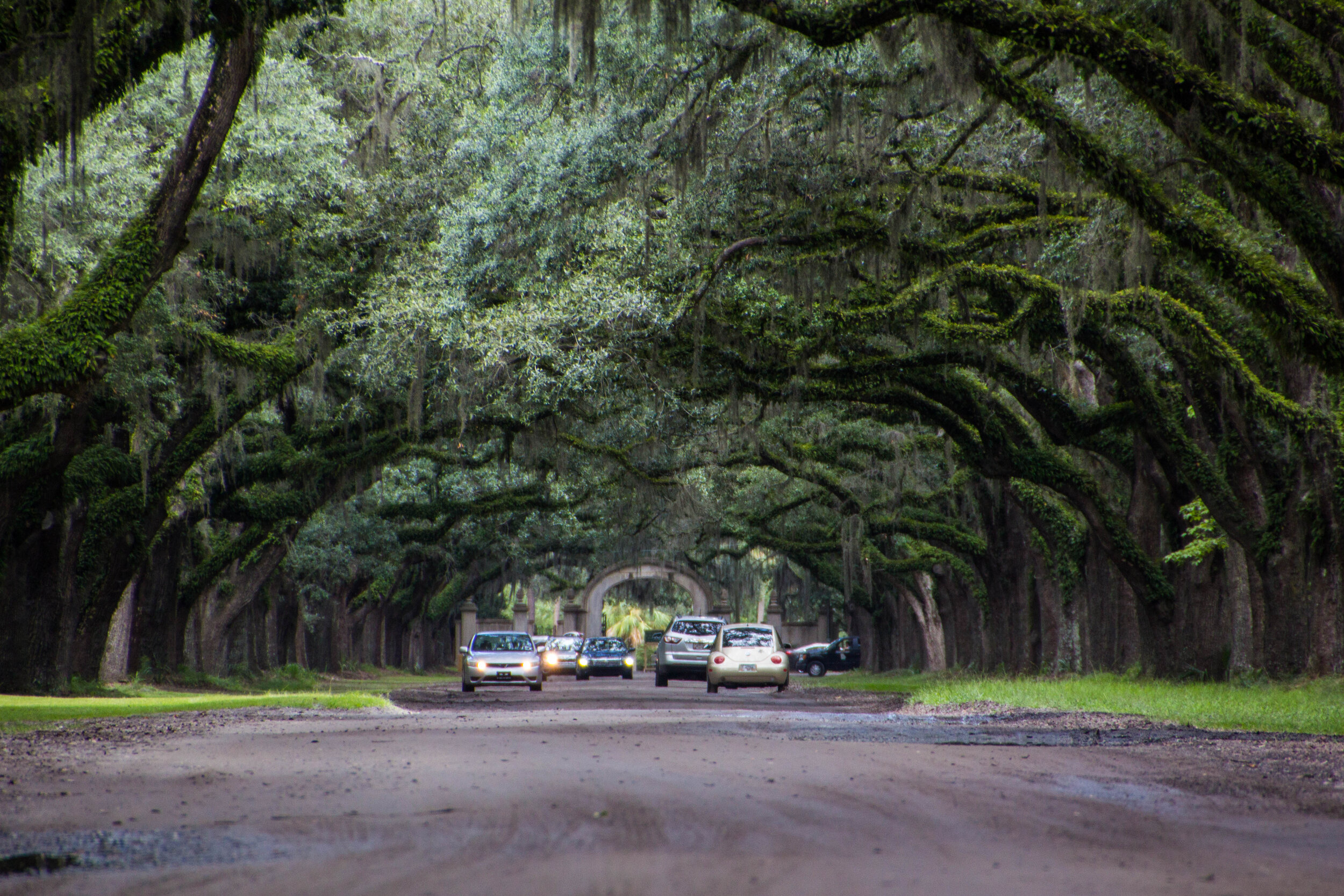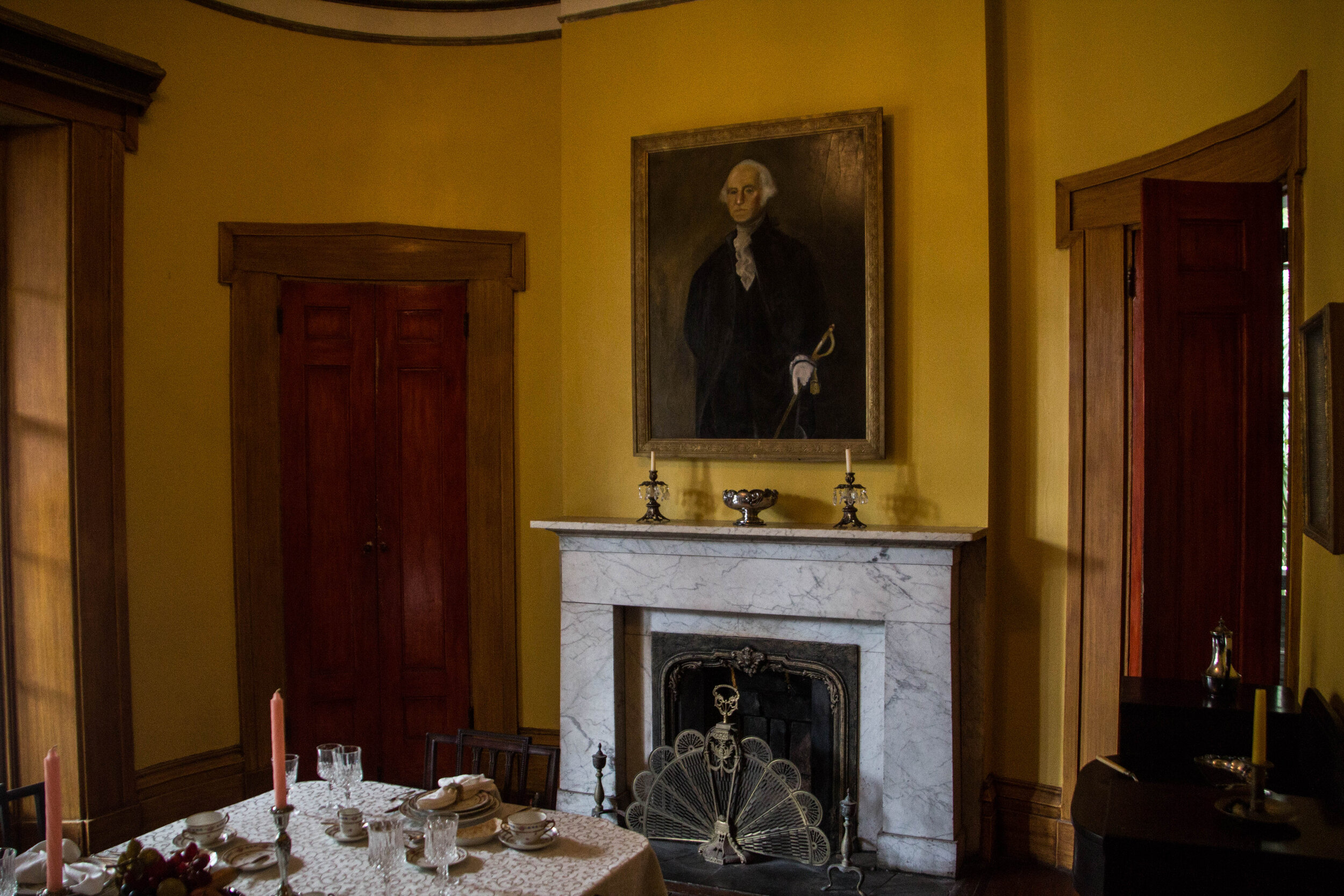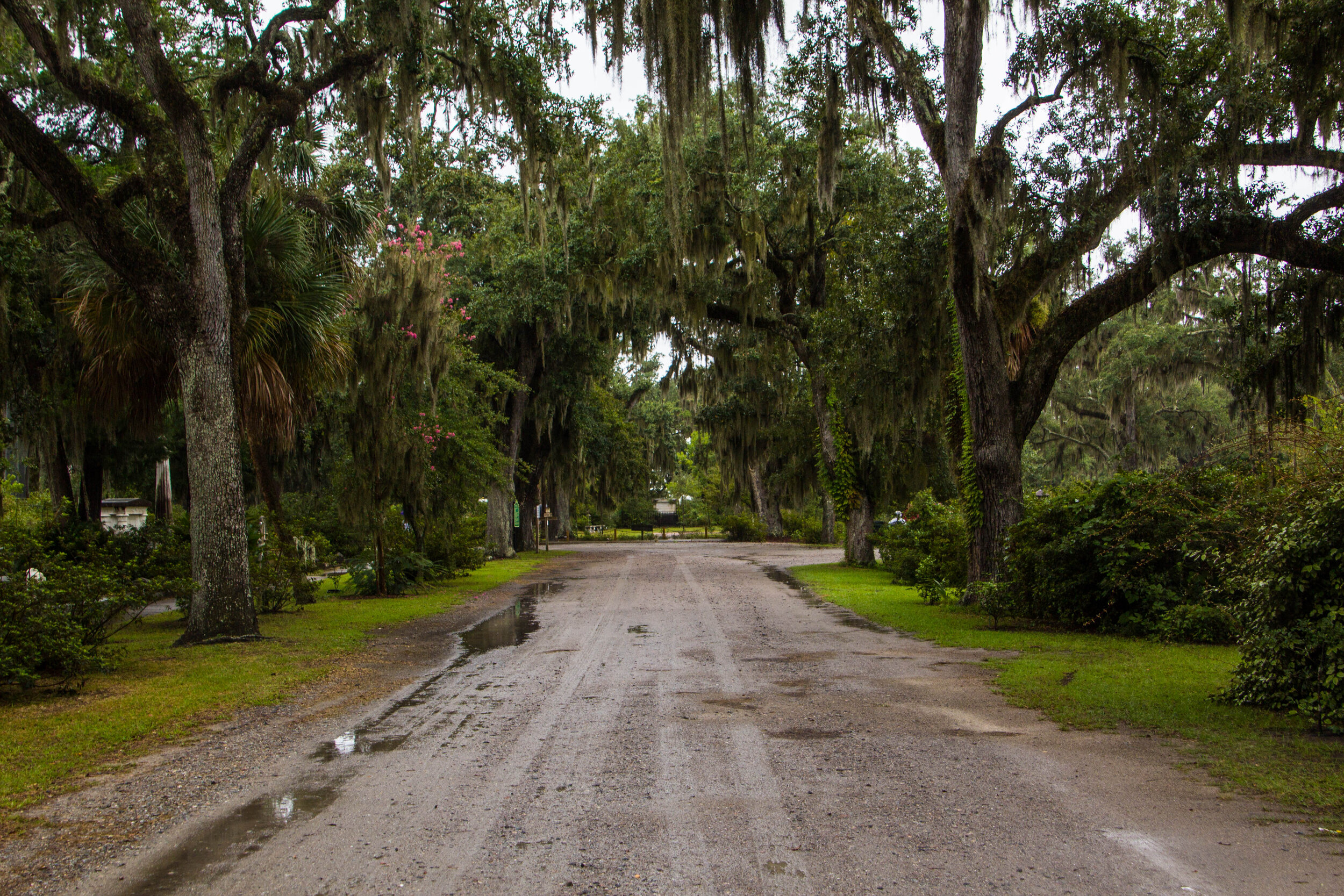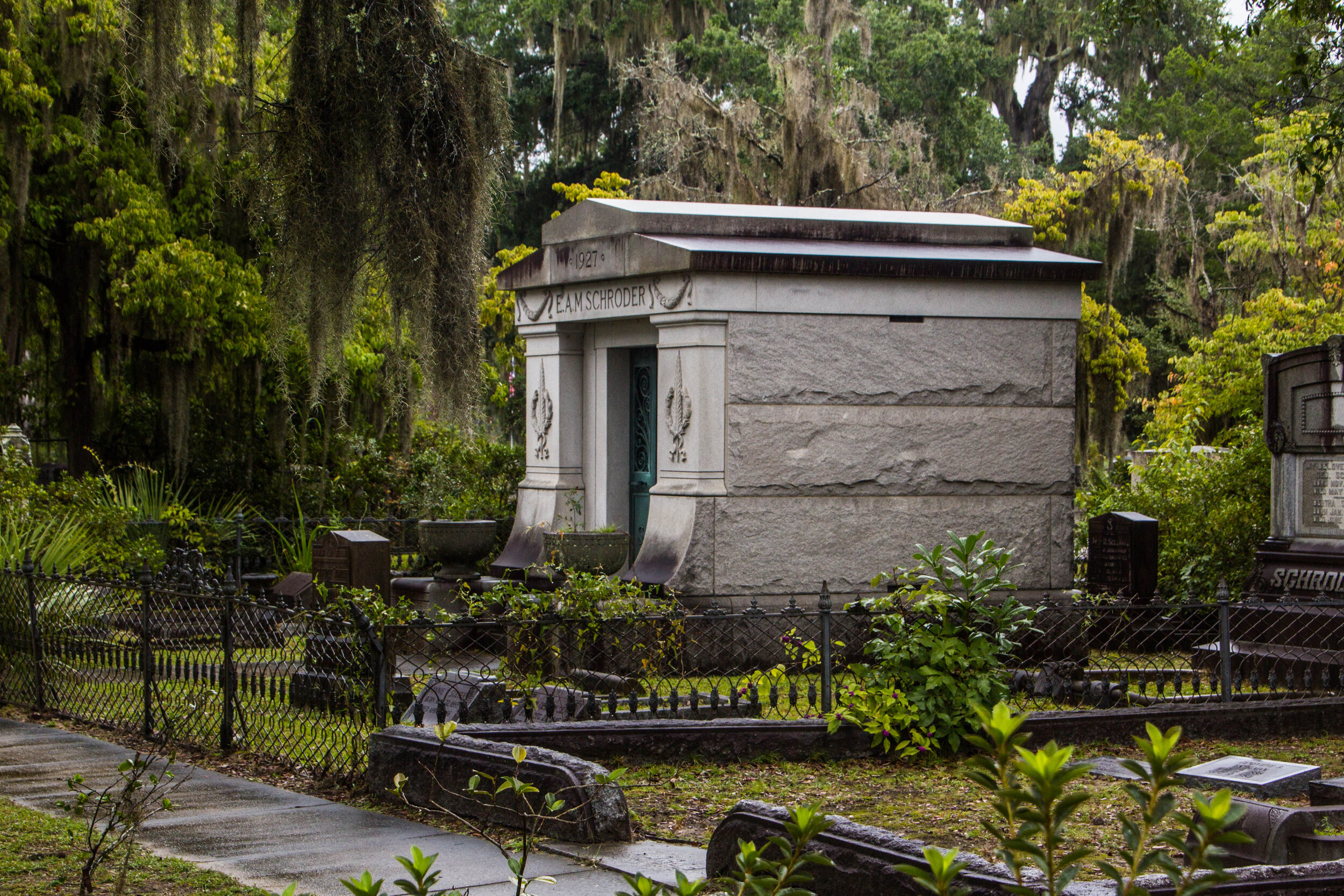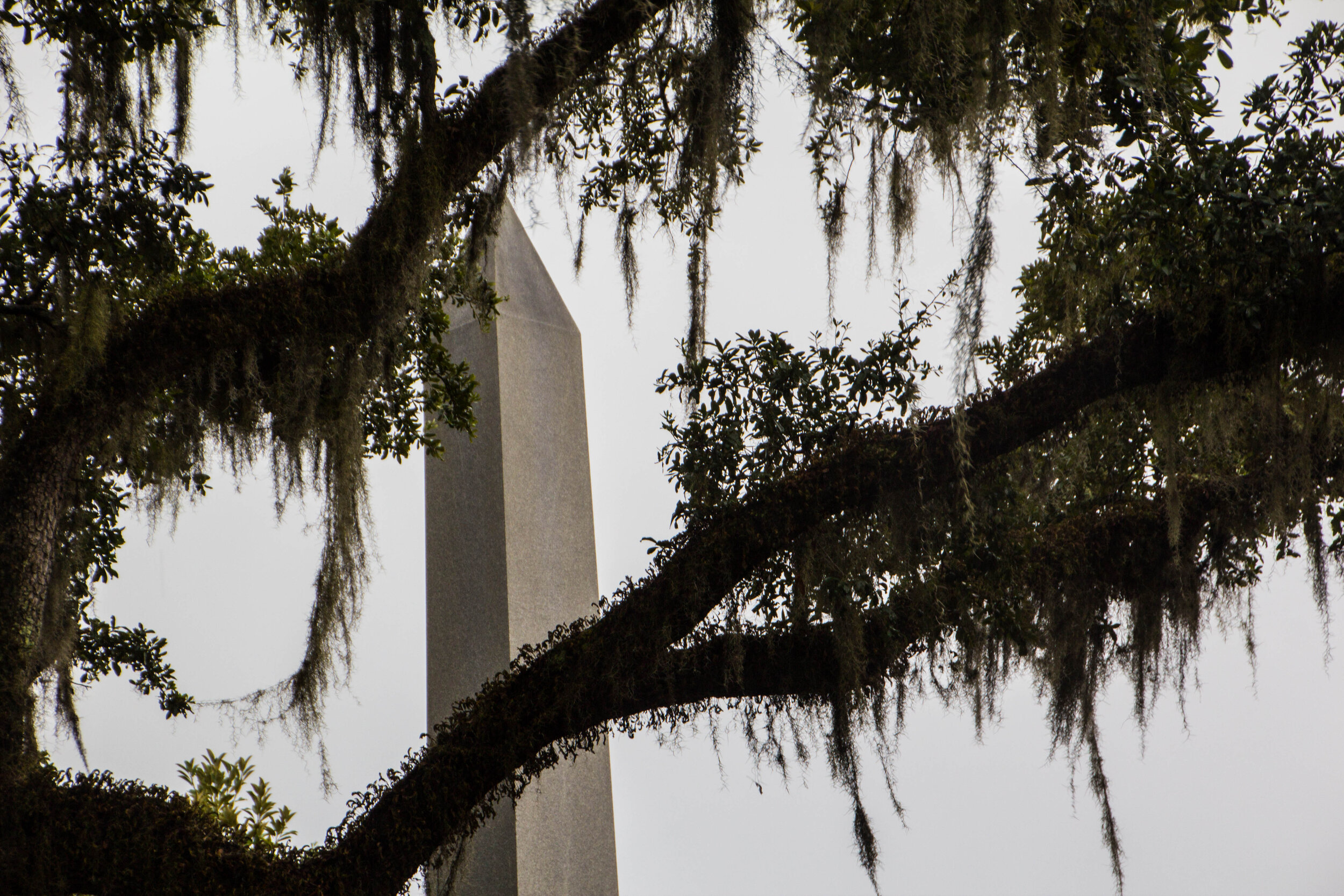In the last article we did a quick introduction to Savannah, and then did some good old fashioned ‘sploring of its enchanting brick streets. To say that this city is beautiful would be an understatement. It’s one of the oldest cities in America, and one of the few surviving time capsules from the pre-Confederate South. Indeed, this city has so many skeletons in its closet that it’s become something of a destination for history and ghost stories. Today we’re going to visit a few sites that are of particular significance in Savannah.
And then we’re going to evacuate before hurricane Dorian gets here!
Wormsloe & Oak Road
When you picture Savannah, what comes to mind?
For most of us, it’s probably a street with lots of overhanging branches arched overhead, hanging from which is lots and lots of Spanish Moss. It’s an iconic sight. We’ve all seen some version of this picture somewhere along the way. And I’m willing to bet that, for at least 70% of us, that picture was taken here, at Wormsloe.
Wormsloe is an old plantation that dates back to before the founding of the U.S. The actual ruins of the plantation are not supposed to be much to look at, but the road that leads those ruins is something of a mecca for visitors to Savannah. I’m not sure that it officially has any sort of name, but it is unofficially known as “Oak Road.” The plan was to drive up, take a few pictures before anybody could tell us not to, and then speed away. But once we actually got here, it was a lot more difficult to pull off this heist than anticipated because everybody else seemed to have the same idea. And at the head of this road, there was some sort of traffic cop / park ranger lady who was running a pretty tight ship forcing everybody to buy tickets for the full package even if they just wanted to see the road. SIGH!
I forked over $25 for a ticket, which felt pretty damn steep, and then resolved to get my money’s worth. Starting with Oak Road. When I had first seen these pictures, I figured it couldn’t be more than ~1 city block long, but this thing turned out to be seemingly never-ending. Seriously, it was probably 10 minutes of driving, with these ancient Oak branches continuously passing overhead. At the start these was a collection of cars that had slowed down to take pictures, but 3 minutes down the road there was barely anyone in sight. Already, I was quite glad that I had bitten the bullet and paid up. Look at this:
When we arrived at the other end of this road, I was pretty satisfied with my purchase. But this road technically only led to the gate of what we had purchased tickets into! So with a shrug, we parked our car and found our way over to the trail head. There are all kind of hiking trails that traverse this property, but weren’t really here for purposes of hiking, so we picked the shortest one, which was only a couple miles. Soon we were deep in the thick Coastal Georgia brush. The last time I was in this region, I was a child on a family vacation to St. Simon’s island and I remember seeing tons of wild armadillos running around a forest that looked a lot like this one. So I was keeping my eyes peeled, but alas, there were no armadillos to be found.
Honestly, the destination of this trail was pretty lame. Most of the more substantial structures were just recreations of what these structures probably would have looked like. The only genuine ruins are the last few pictures below. It was the frame of a once-large building that had been made out of a particular kind of cement typical of this region / time period called tabby. Basically it’s just concrete that uses lots of sea shells. But let me tell you a bit about it anyway…
The Wormsloe plantation was owned by a man named Noble Jones, who purchases this plot of land on the Isle of Hope in 1736. Here he constructed a fortified house, followed later by additional fortifications, a plantation, and eventually a mansion. Most of this stuff is gone now. Only these ruins remain. The location along the Skidaway River, which is a way-point on the Intracoastal Waterway, was strategic, as it was roughly halfway between Savannah and the Atlantic. At this time, this was something of a conflict zone, with English settlers fighting the Spanish and their Native American allies for control. History would see Spanish influencer in the region subside, making way for cities like Savannah to flourish.
Here are some pictures of the loop we hiked. The history is interesting, but the best parts of this hike were the views out over the salt marshes of the Intracoastal Waterway. There’s entire cities of fiddler crabs out there.
Sorrel-Weed House
At 16,000 square feet, the Sorrel-Weed House is one of the largest homes in Savannah. It’s something of an architectural case study, it was the 2nd house in Georgia to be made a state landmark, and it sits right in the heart of one of the most beautiful parts of Savannah, directly between Forsyth Park and Downtown on Bull Street and Harris Street. This house was opened to the public for tours in 1940, and is somehow still heavily under renovation. Also, supposedly it’s haunted. We were hoping to get some of that on the tour that we took, but apparently they only do the ghost stuff on the night tours. During they day they just talk about the family that lived here, and small society of slaves that lived ass-to-ankles in the shed out back. You can book a tour for yourself here.
This was once the house of a notable officer confederate army, Brigadier General Moxley Sorrel. He clearly ended up on the wrong side of history, but he wrote an account of his experience in the war called “Recollections of a Confederate Staff Officer” that is considered to be one of the best post-war accounts written. His father was a friend of General Robert E. Lee who was the confederate Godfather during this conflict.
While we’re on the subject of the Civil War, let me quickly touch on the slave situation in this house. I feel like slavery (or race) is the elephant in the room in any historic site in the American South. You don’t always NEED to acknowledge it if you’re not trying to open that can of worms, but it really stuck out to me here. The first piece of the tour was of the basement and the carriage house out back, which would have primarily been where the slaves lived and worked, and… yeah, it wasn’t great. And it didn’t get much better from there.
Honestly, this whole facet of American history feels pretty “under the rug” in cities like Savannah sometimes. I’m a white kid born in the north in the 1990s—so I’m decently well removed from the South and all its baggage—but even though my ancestors were on more or less the right side of history, I definitely have a lot of white guilt on tours like this. People in the south often strike me as a little bit too accepting of their history… but then again, we all need to be able to take some kind of pride in our heritage, and I can’t reasonably expect them to bring out their own white guilt for me like a dog & pony show just to demonstrate that they’re not racist. Everybody has some of that inside of them, and I am no exception. It’s not like they were alive for any of this either. We all exist in more or less the same society today, and enjoy the same level of privilege because of the color of our skin. We’re all trying to process the same shit and figure out what it means for our day-to-day lives. Southerners don’t need to prove anything to Northerners. We all share responsibility. All any of us can do try to make some change wherever we are and hope for the best.
I guess I’m just not sure how to enjoy a beautiful city like Savannah for what it is without acknowledging that it was literally built on the backs of African slaves. So this is that acknowledgement. 🤷🏻♂️
BonAventure Cemetery
Have you ever heard of a book called “Midnight In The Garden of Good and Evil”?
Or if not, maybe you’ve seen the movie? It was directed by Clint Eastwood and starred Jude Law, Kevin Spacey, John Cusack, and some other famous people…
Well if you don’t know about this, don’t worry. I didn’t either. It’s a famous book that written about a the real-life murder of a young man that happened in Savannah in the 1980s. It’s an interesting southern gothic novel with lots of eccentric personalities and fascinating vignettes of what life was like the Savannah of the past. The book is supposed to be really good (I haven’t read it); the movie was just okay, but interesting to watch if you’re getting ready to visit Savannah.
Anyway, I’m telling you about this now because the cover of the book is an iconic piece of Savannah lore. And that picture was taken here, in Bonaventure Cemetery, of a headstone / statue known as “The Bird Girl”. People used to flock to this place to track down The Bird Girl and snap their own picture, but apparently she has since been relocated. So the cover of this book just a snapshot in time now. But it’s still a powerful image that is something of a calling-card for Savannah. And the cemetery itself still retains that same vibe, so here we are.
The morning that we visited there was a storm picking up steam. The cemetery is actually located just outside the city, and area called Thunderbolt. Watching the flashes of lightening overhead as we made our way through the maze of arching branches draped with Spanish Moss towards the cemetery gates, I couldn’t help but think it was a fitting name. “Thunderbolt.” Anyway, the beginning of our tour was quite wet, but the weather had calmed down enough for me to dig my camera out of my dry-sack by the end of the tour. On this tour, we learned about the founding of this cemetery back in 1846, and all the notable people who were buried here. The most notable inhabitant seems to be a film / music guy named Johnny Mercer. Based on the story our tour guide told, it seems a lot like his wife killed him… but who’s to say. Everybody involved in that story is dead now.
Anyway, here are a few images that I snapped between downpours. In spite of the weather, was really captivating environment. Definitely lends itself to the lore and ghost stories associated with Savannah. Oh, and if you’re in the market for a tour guide, we used a lady that called herself “Dawn of Savannah’s Dead.” She definitely had pizazz. You can book a tour with her here.
The Mercer Williams House
Piggy-backing off of the background provided above on Midnight in the Garden of Good and Evil, I’m going to end with the Mercer Williams House. This is probably the most famous house in all of Savannah because this is where the alleged murder happened. You see, this was the house of a notable Savannah socialite, Jim Williams. He was a world-renowned antique dealer and historic preservationist. He played a big role in the perseveration of Savannah, so we have—at least in part—him to thank for how pretty this place has managed to remain. He traveled all over the world collecting all sorts of crazy antiques and was a wealthy, well-respected man about town in Savannah through the 1970s, 1980s, and 1990s. That’s his picture here.
And, allegedly, he shot and killed a younger man that we was allegedly receiving sexual favors from named Danny Hansford inside what is now known as the Mercer Williams House. It’s rumored that Danny was actually a male prostitute, but all of this is really speculation. In the first trial he was found guilty and sentenced to life in prison, but he posted a $200,000 bond and appealed. During the appeal (trial #2), new evidence came to light that the arresting officers had contradicted themselves in their statements, and his conviction was overturned. He was later brought to trial again for the same crime (trial #3), but because of 1 single stubborn juror, the result was a hung jury and a mistrial. So naturally, he was then tried A FOURTH TIME (trial #4), and promptly and soundly found not guilty. That makes him the only person in the history of Georgia to have gone to trial 4 times for the same crime. SO DID HE DO IT?!? Don’t know, but in the movie version of Midnight in the Garden of Good and Evil, he was played by Kevin Spacey, and that dude DEFINITELY is guilty of some stuff. So… 🤷🏻♂️
Now, unfortunately, there is no photography allowed inside the Mercer Williams House. They also do not comment on the alleged murder. The people who run this place are full-on antique nerds who give a pretty compelling tour on that alone. There was stuff dating back to the 1500s from China, Persia, Holland, France, and more. Here’s a couple pictures of the house from the outside. If you want to see the inside, you’ll have to watch the movie of Midnight in the Garden of Good and Evil. Parts of it were filmed in here. You can buy tickets to take a tour of your own right here.
My First Hurricane Evacuation 😅
It was the night before we were set to leave. My girlfriend, who was traveling with me here in Savannah, was already asleep. We knew that Hurricane Dorian was brewing somewhere out there on the Atlantic. The weather over the past few days had been a bit volatile, but the past 36 hours had actually been absolutely perfect. We felt pretty lucky to have been able to experience Savannah under such perfect weather conditions, but our luck was about to run out.
I was making the rounds of our Airbnb to make sure my bags were mostly packed so we could scoot out relatively early the following morning, when I got an alert on my phone. Governor Brian Kemp (fuck that guy btw) had ordered a mandatory evacuation of Savannah, effective at noon tomorrow. With a sigh, I woke up the GF and showed her the headline.
Bleary-eyed and disheveled, she thought for a moment, and then looked up and asked, “Should we just leave now?”
We ended up leaving right then and there. I had never even been close to a hurricane, so I wasn’t sure what to expect. The one certainty seemed to be that if we waited until morning, we would be sitting in traffic for HOURS. So, at 12:30am, we packed up our Airbnb, got in the car, and started the long voyage out of Savannah. It was a Sunday night and the streets were absolutely empty. The 3 hours of flat nothingness between Savannah and Macon was pitch black, but we made good time. We were back in Nashville (our home base) by 8am the next morning. That drive was pretty awful, but we did it in shifts and stopped for coffee more than once.
The next day, after we had recovered, we were talking to our roommate, who happens to be a Savannah native, and he told us that his family had been sitting in stand-still traffic on Route 16 for about 3 hours. Turned out we made the right call. That traffic would have been awful. And what exactly happened when Dorian hit Savannah? Well… it actually never did. It completely missed Savannah and there was no damage to the city whatsoever. You can read about it here. Savannah should have gotten hit by hurricanes so many times in the past, but somehow it never does. The last time Savannah suffered a direct hit from a hurricane was 1898.
Still, I feel older and wiser for having gone through an emergency hurricane evacuation. 💪⛈




